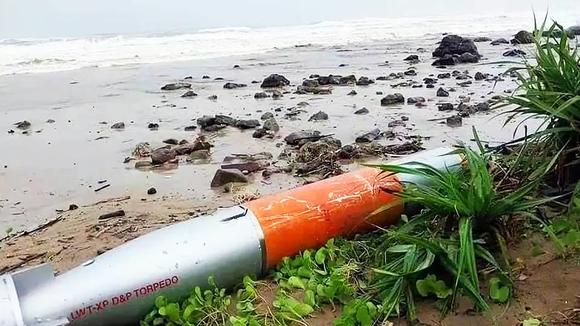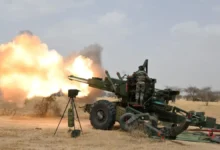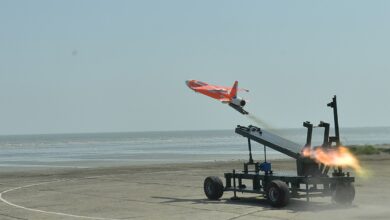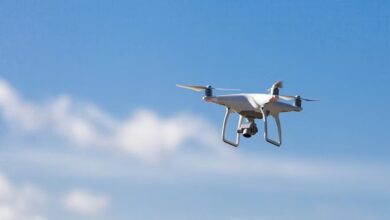‘Made-In-India’ A Torpedo Washes Up On Myanmar Beach; Military Launches Investigation, Netizens Puzzled

- The Shyena torpedo is nine feet long and was developed for the Indian Navy by the Naval Science and Technological Laboratory of the Defence Research and Development Organization.
- The Shyena torpedo is nine feet long and was developed for the Indian Navy by the Naval Science and Technological Laboratory of the Defence Research and Development Organization.
Myanmar’s military, according to reports, has already launched an investigation. The images were first shared on Twitter by a user who wrote, “An unexploded torpedo was discovered on a beach in Burma!” After verification, this is the Indian Navy’s LWT-XP light torpedo.”
Rakhine is a western Myanmar region bordering the Bay of Bengal. Experts believe the torpedo washed up at this location because various navies frequently conduct drills there.
For example, the Indian Navy and the US Navy participated in Exercise Milan 2022, a naval exercise in the Bay of Bengal, in late February this year. Similarly, the Indian Navy and the Japan Maritime Self-Defense Force participated in a Maritime Partnership exercise in the Bay of Bengal in January 2022.
The torpedo is silver in colour, with the inscription “D&P torpedo” and serial number “LWT-XP” on it. Given the designation, the weapon is most likely a Shyena Advanced Light Torpedo (TAL), India’s first indigenous lightweight anti-submarine torpedo. The service began to field it in 2012, following its production.
Does It Belong To The Indian Navy?
Despite sporadic reports claiming that the Indian Navy was to blame for the torpedo’s appearance, experts have pointed out some other facts. In March 2017, India and Myanmar agreed to a $37.9 million contract to export an unspecified number of Shyenas to the Myanmar Navy.
According to The Diplomat, Myanmar received the first shipment of those torpedoes in July 2019. According to the report, India’s Prime Minister Narendra Modi made an effort to improve relations with Myanmar as part of the pre-established Act East policy, formerly known as the Look East policy.
Furthermore, as previously reported by the EurAsian Times, India will present a Russian-built Kilo Class submarine to the Myanmar navy on December 24, 2020. It was done in part to counteract China’s growing influence in the region.
The Shyena torpedo is nine feet long and was developed for the Indian Navy by the Naval Science and Technological Laboratory of the Defence Research and Development Organization. It was designed to be launched by specific Indian Navy ships, submarines, and helicopter types.
While orange appears to be a colour that is commonly used in the design of an armed Shyena in some way, the silver coating and thick orange stripe visible in the photos are not.
This proves that it is a training round because bright colours are frequently used to make such munitions easier to recover after training exercises. Furthermore, “D&P” could stand for “drill and practise,” a term commonly used to refer to inert training weapons and ammunition.
Vice Admiral Arun Kumar Singh (Retd) noted in a similar vein that the torpedo is a “practice/experimental test torpedo” that “apparently was lost post firing, despite having a SOP for firing & recovery of such torpedoes.”
Myanmar’s Navy’s Recent Exercise In The Region
A Twitter user also pointed out that the Myanmar Navy recently issued a warning to the local population about upcoming naval exercises scheduled between June 23 and July 9.
The notice reportedly asked civilians to avoid the area during the specified time frame. Experts believe that such warnings are frequently issued prior to drills involving live fire, such as torpedo or anti-ship missile tests.
恐怖! #缅甸 海滩上出现一枚未爆炸的鱼雷!经查证,这是来自 #印度 海军的LWT-XP轻型鱼雷
Horror! An unexploded torpedo was found on a beach in #Burma ! After verification, this is the LWT-XP light torpedo from the #Indian #Navy . pic.twitter.com/AozEmkotUB— Michael Franklin ( 100% follow back) (@Michael04222710) July 13, 2022
The “Sea Shield 2022” exercise fits this description and the timeframe specified by the Myanmar Navy alert. The exercise began on July 1 and took place off the coast of Rakhine, where the unarmed torpedo was discovered.
This year’s Sea Shield featured 20 warships, including frigates, submarines, and helicopters piloted by Myanmar’s Air Force, according to local news sources. Some internet users even shared photos purportedly from the exercise.
At least three rounds can be seen mid-launch from a ship’s deck in those images. One of the weapons has a thick orange stripe that resembles the one found ashore.
Torpedoes used for training are typically recovered after being launched in drills such as Myanmar’s Sea Shield. However, rumours suggest that this year’s training event was held in inclement weather, which may have contributed to the current situation.






Facebook Comments